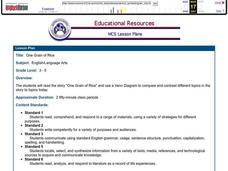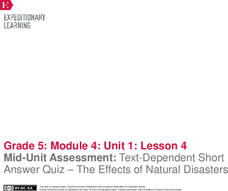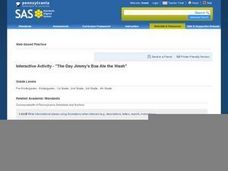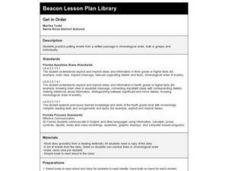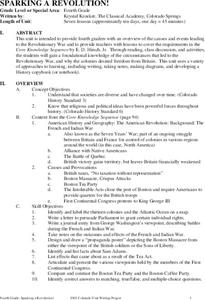Curated OER
Exploring Gullah Culture...Through Language and Numbers
First graders examine the culture of the ancient Gullah people. As a class, they practice saying and writing the days of the week and numbers in Gullah. They are read a Gullah folktale and put the events of the story into the correct...
Curated OER
Everyone Sang - Moods in Poetry
Start by reading the poem "Everyone Sang" by Siegried Sassoon. The archive also houses an audio clip, so consider playing that instead of reading it aloud. After hearing the poem twice, middle and high schoolers will discuss a list of...
Curated OER
Egypt, Mesopotamia, Indus River, and Huang He Civilizations
Students develop a timeline of events associated with Egypt, Mesopotamia, the Indus River, and the Huang He. They prepare a clay, wood, or paper model of a representative artifact from one civilization. They write a description of their...
Curated OER
Narrative Writing vs. Explanatory Writing
The class discusses the different purposes an author has for writing. The focus of the discussion is on writing to tell a true story and writing to give information about a specific topic. There are writing purpose sorting cards embedded...
Shutterfly
Shutterfly Photo Story Lesson Plan
A reading of Peggy Parish's Amelia Bedelia launches a study of idioms. Groups then select several idioms, write the meaning of the expressions, draw or select images, and use GIMP or Photoshop to create an idiom book.
PBS
Copyright and Fair Use
When is using someone else's copyrighted material appropriate? Learn about copyright and fair use with a lesson from PBS.org. Scholars read through a reference sheet about authors' rights and users' rights, and then create posters for a...
Curated OER
One Grain of Rice
Upper graders read the story One Grain of Rice, and use a Venn diagram to compare and contrast topics found in the story to current event topics today. Groups of three learners work together to create their diagram. The topics they must...
EngageNY
Mid-Unit Assessment: Text-Dependent Short-Answer Quiz—The Effects of Natural Disasters
Readers complete a mid-unit assessment by reading the text How Do Hurricanes Form? They answer text-dependent questions about hurricanes with short answer and sequencing. Learners then participate in a read aloud and text chunking...
Curated OER
What Was Columbus Thinking?
Why is Christopher Columbus one of the most studied figures in history? Upper graders will investigate why Christopher Columbus traveled to the New World and what happened to the native people he encountered. They read and discuss...
Curated OER
Living in the Desert
Conduct an investigation on the plants used by the Hohokam tribe. To survive in the harsh desert environment the Hohokam used many natural resources. Learners read, research, map, and graph multiple aspects of Hohokam plant use as a...
Curated OER
Checking Sources For Accuracy
Middle schoolers will paraphrase a resource without plagiarizing. Then rewrite after reading text. They then evaluate the site or reference they are using for accuracy. In the end, they complete a note-taking organizer.
Curated OER
What Happened Next?
Fifth graders read one short story on their own. After reading, they are given a series of sentences and events from the short story and put them into the correct sequence. To end the lesson, they draw pictures from the story and...
Curated OER
Hard Word with the Little Red Hen
Students complete a unit using the story of the Little Red Hen to learn the storybook reading format as well as improve their reading and social skills. In this storybook lesson, students complete five lessons using the story of the...
Curated OER
Story Wheels
Students use a Story Wheel to summarize a novel, practice sequencing skills, visualize story elements and recognize story structure. In groups, they each complete a piece of the story wheel and put it all together. They complete the...
Curated OER
Poultry in Motion (The Little Red Hen Meets Chicken Little)
Students read stories and use reading and writing skills to sequence, compare and contrast, predict, and identify parts of a story. Six lessons on one page.
Curated OER
The Dashiki
Learners read verbs with different forms and endings, sequence events, gain knowledge of cause and effect and learn to use a glossary. They read the book, "The Dashiki" in small groups with the teacher focusing on how students decode an...
Curated OER
The Day Jimmy's Boa Ate the Wash
Students read the story The Day Jimmy's Boa At the Wash and put the event boxes in order from the beginning to end of the story. In this sequencing lesson plan, students do this on the computer.
Curated OER
The Littlest Matryoshka
Students listen to the story The Littlest Matryoshka and sequence the story. In this sequencing lesson plan, students sequence the story and also make little dolls based on the story and write stories about them.
Curated OER
Get in Order
Students practice putting events from a written passage in chronological order, both in groups and individually.
Curated OER
Sparking a Revolution!
Students investigate the causes and events that lead to the US Revolutionary War. They use a number of study techniques in this unit to discuss why the colonies wanted freedom from Britain.
Curated OER
Which Came First?
Pupils examine the significance of the Louisiana Purchase and the journey of Lewis and Clark. They sequence events that occurred on the journey of Lewis and Clark.
Curated OER
Jack and the Beanstalk
In these reading comprehension worksheets, students complete several activities to help them learn about Jack and the Beanstalk. Students complete a cloze exercise, a reading comprehension activity, a story sequencing activity, and an...
Curated OER
The Secret School: chapters 2 and 3
Second graders read chapters 2 and 3 of The Secret School and answer discussion questions as they read. In this reading lesson plan, 2nd graders also read aloud in pairs and complete a worksheet.
Curated OER
What's Holding Up the Water?
Learners read about the history and locate dams in Arizona. In this Arizona dams lesson plan, students write a summary about what they read focusing on word choice, ideas, conventions, and geography content.








